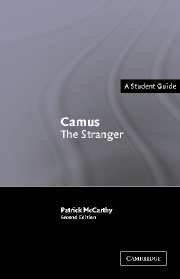3 - Early Camus and Sartre
Published online by Cambridge University Press: 05 June 2012
Summary
As stated in Chapter 1, Camus considered that The Stranger, Caligula and The Myth of Sisyphus should be read together, because they make up the cycle of the absurd. However, Camus also writes in The Myth that the works of an absurd artist may seem ‘to have no connection one with the others’ (OC 2,190). Caligula has few significant links with The Stranger and hence we shall treat it briefly. The Myth will be discussed at greater length because it takes up the issues of Meursault's growing awareness and of the religious motif in the last chapter. Indeed it will be argued that The Myth represents both a conclusion and an interpretation of The Stranger, even if its interpretation resolves in an unsatisfactory manner the ambiguity of Part 1.
There are contrasts and parallels between The Stranger and Sartre's early fiction, Nausea (1938) and The Wall (1939). While Camus recognized the kinship between his sense of the absurd and that of Sartre, the differences between them were great and the origins of their famous quarrel in 1952 may be traced to their early writing. A glance at Camus's other books and at the young Sartre enables us better to situate The Stranger.
The cycle of the absurd
Caligula does not belong entirely to the same period of Camus's writing as The Stranger and The Myth, because it was revised in 1944, 1947 and 1957.
- Type
- Chapter
- Information
- Camus: The Stranger , pp. 72 - 86Publisher: Cambridge University PressPrint publication year: 2004



